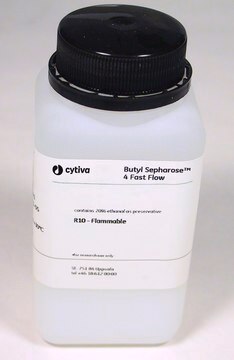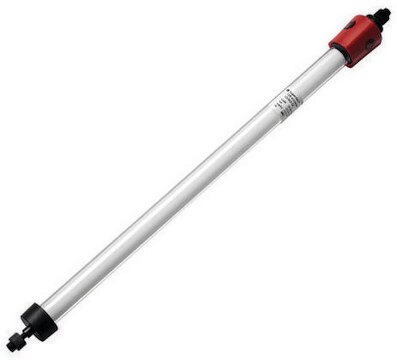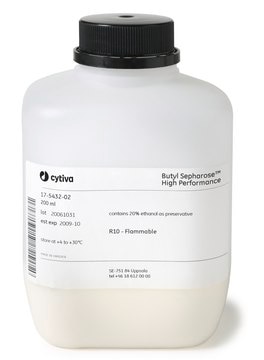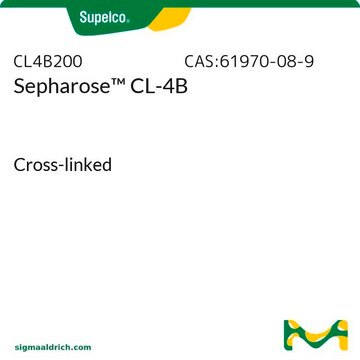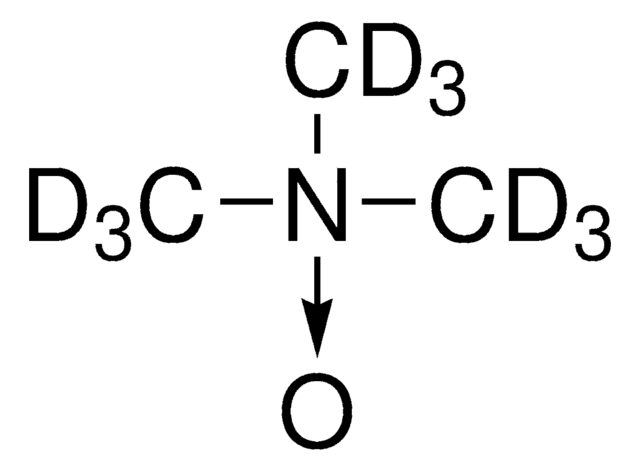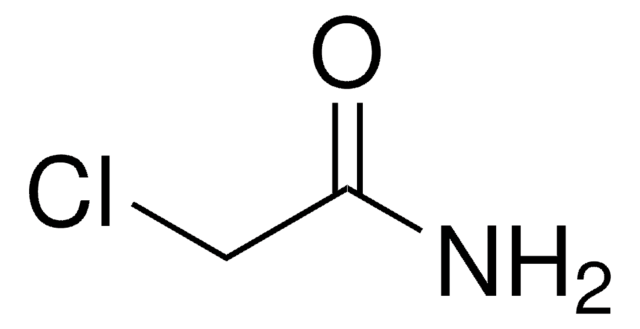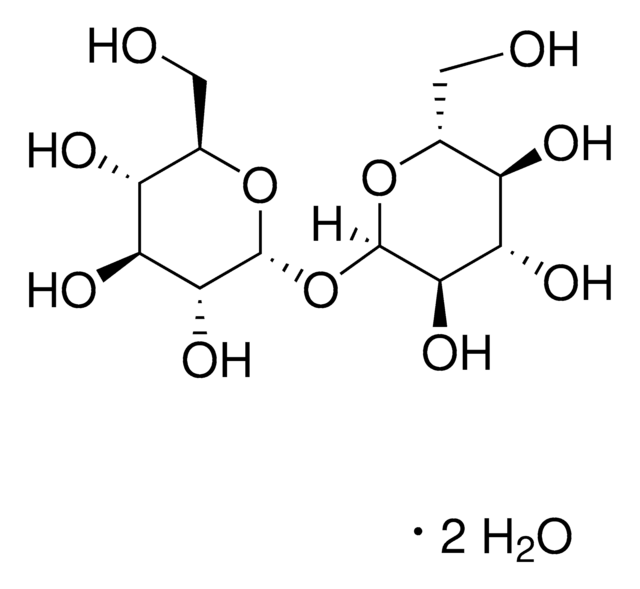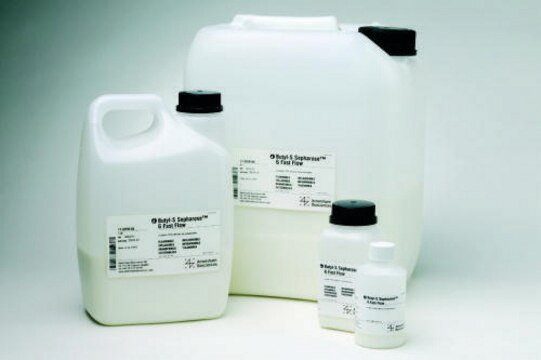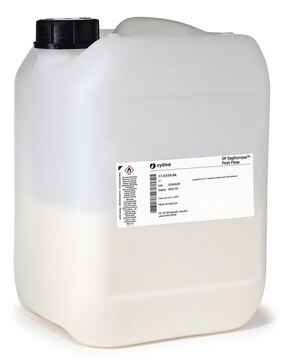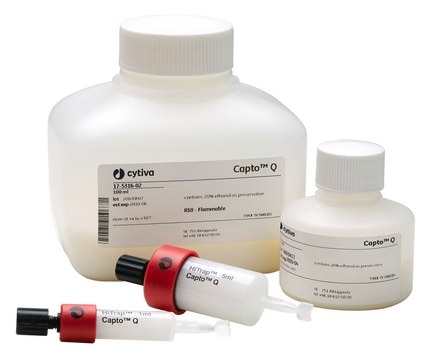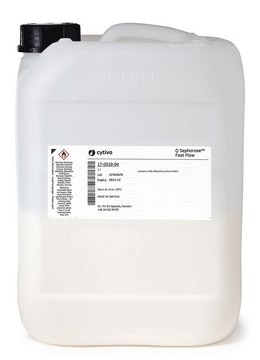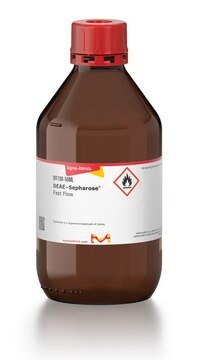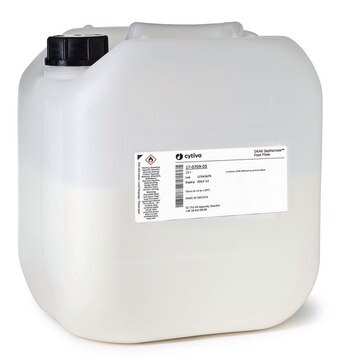B9041
Butyl-Sepharose™ 4 Fast Flow
Anmeldenzur Ansicht organisationsspezifischer und vertraglich vereinbarter Preise
Alle Fotos(1)
About This Item
Empfohlene Produkte
Form
suspension
Qualitätsniveau
Kennzeichnungsgrad
~50 μmol per mL gel
Matrix
agarose, 4% crosslinked
Matrixaktivierung
epoxy
Matrixanbindung
ether
Partikelgröße
45-165 μm
Lagertemp.
2-8°C
Anwendung
Butyl Sepharose™ is used in affinity chromatography, hydrophobic interaction media, separation media and resins. Butyl-Sepharose™ has been used to study inflammatory diseases.
Physikalische Form
Suspension in 20% wässrigem Ethanol
aqueous ethanol suspension
Rechtliche Hinweise
Sepharose is a trademark of Cytiva
Signalwort
Warning
H-Sätze
Gefahreneinstufungen
Flam. Liq. 3
Lagerklassenschlüssel
3 - Flammable liquids
WGK
WGK 1
Flammpunkt (°F)
102.2 °F
Flammpunkt (°C)
39 °C
Analysenzertifikate (COA)
Suchen Sie nach Analysenzertifikate (COA), indem Sie die Lot-/Chargennummer des Produkts eingeben. Lot- und Chargennummern sind auf dem Produktetikett hinter den Wörtern ‘Lot’ oder ‘Batch’ (Lot oder Charge) zu finden.
Besitzen Sie dieses Produkt bereits?
In der Dokumentenbibliothek finden Sie die Dokumentation zu den Produkten, die Sie kürzlich erworben haben.
Kunden haben sich ebenfalls angesehen
Beckley K Nfor et al.
Journal of chromatography. A, 1218(49), 8958-8973 (2011-08-27)
Salt-induced protein precipitation and hydrophobic interaction chromatography (HIC) are two widely used methods for protein purification. In this study, salt effects in protein precipitation and HIC were investigated for a broad combination of proteins, salts and HIC resins. Interrelation between
Investigation of protein retention in hydrophobic interaction chromatographic (HIC) systems using the preferential interaction theory and quantitative structure property relationship models.
Chen, J., et al.
Reactive functional Polymers, 67(12), 1561-1569 (2007)
Chemical and chromatographic characterization of a new bioprocess? medium for hydrophobic interaction chromatogrpahy: Butyl Sepharose? 4 FastFlow.
Berggrund, A., et al.
Process. Biochem., 29(6), 455-463 (1994)
Patrícia P Aguilar et al.
Journal of chromatography. A, 1218(46), 8322-8332 (2011-10-04)
In the present study, Angiotensin I (Ang I) will be used as model peptide to assess on-column alteration of conformation phenomena. Adsorptive behavior of Ang I on various commercial hydrophobic interaction surfaces (Butyl, Octyl and Phenyl - Sepharose), under different
Wei Yang et al.
Protein expression and purification, 76(1), 59-64 (2010-09-11)
Dipeptidyl peptidase I (DPPI) plays a crucial role in maturation of many regulatory peptides and has been suggested as a pharmaceutical target in several inflammatory diseases. It is also a useful processing enzyme for the generation of authentic protein products
Unser Team von Wissenschaftlern verfügt über Erfahrung in allen Forschungsbereichen einschließlich Life Science, Materialwissenschaften, chemischer Synthese, Chromatographie, Analytik und vielen mehr..
Setzen Sie sich mit dem technischen Dienst in Verbindung.